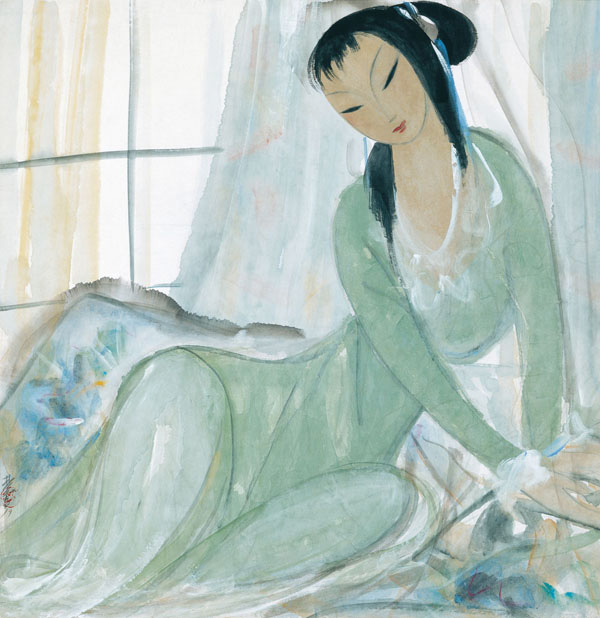Painter Shiy De-jinn once praised Lin Fengmian's art as the "Innovation Pioneer of Chinese Painting" He thought that being an innovator in painting was ten times far more difficult than being a successor. To truly revolutionize Chinese painting is easier said than done. To remake a prototype steeped in several thousand years of cultural essence would be even more difficult. Yet, Lin Fengmian managed it. He surpassed traditions and combined the best of both East and West. His paintings opened up a whole new horizon.
Lin Fengmian was among the first generation of artists from China to study in France. In 1920, he went to further his studies in Paris, enrolling into a collegiate education to learn western painting. In the beginning he loved intricate realistic paintings. Styles such as Classical paintings, Fauvism and Cubism brought new impact on his visual sense, but, inspired by his teacher, he turned to study Chinese sculptures, paintings and ceramic art in eastern museums, developing a keen interest in traditional Chinese art. The interest shown in the East was synonymous with European ideologies then. Even artists such as Picasso and Matisse were learning from the experiences of Eastern art. Lin Fengmian once copied the simplistic landscapes, flowers and birds found on ceramics, while the shapes of the vases and their cool glossy sensations were reflected in his later pictures of cranes and beautiful ladies. Folk art such as shadow puppets, Han script carvings etc, further nourished his painting lingo.
Lin Fengmian is the youngest principal ever in charge of an art school in the history of China. He was only 26 when he returned home to take charge of affairs at the Beijing School of Art. Two years later, he set up the National Academy of Art (i.e. Hangzhou College of Art) and assumed the role of principal, introducing western modern art ideologies into China. During the period of his involvement in art education, Lin Fengmian influenced many upcoming students with his free and easy approach to teaching and learning. He is hence regarded as one of the greatest artists and art educators in the 20th century.
The current auction lot, "Lady in a Green Dress" is one of Lin Fengmian's early paintings on beautiful ladies. The approximate date of completion is the 1950s. By then, he had already left his teaching post, choosing to ignore the mundane affairs and to reside in Shanghai without any fanfare. This was the most critical period in the formation of the artist's personal style. Shiy De-jinn believes that the seemingly endless period of residency in Shanghai after 1952 was the most productive period for Lin Fengmian's works of art. His paintings took in equal proportions of elements from traditional Chinese art as well as 20th century Parisian new art. Taking figure paintings for example, his ladies in ancient costumes adopted sitting postures alike Guanyin, the bent body shapes are Matisse-like, while the inclining postures are from Modigliani's; opera figures, on the other hand, combines the structure of cubism with the shapes of shadow puppets.
Under the painter's brushes, the painting "Lady in a Green Dress" incorporated the aesthetics from both East and West. The cotton net and window grilles are in subtle styles of beautiful eastern art decorations. The lines dissecting the canvass are the very elements construing modern painting; the colorful carpet in the background seems to bear influences left by Matisse's Orientalism doctrine. The tight fitting clothes and accessories disclosed the sensuous beauty and charms of the lady, demonstrating the adulation that western nude art have towards the lusts shown in "odalisque" However, the charm and appeal emoting from within Lin Fengmian's lady painting are reserved and implicit in nature, a poise and elegance exclusive to eastern women. The slender long contours of the lady, and the flowing sleeves, reveal the painter's prowess with a brush. The white powder on the costume and accessories gave them a sparkling gloss alike Song china and light seeping out behind the lady created an obscure appeal.
The painting reflected the artist's aesthetical inclinations. Of course, it also contained the memories of his youth. Ladies under Lin's brushes were mainly derived from the faces of his wife, lovers, students and daughters. And because of the feelings and sentiments that accompany the memories of their looks, he always presents their best side. Ever since his stay in Chongqing, the KMT ruled area, during the 1940s, painting ladies has played an important role in Lin Fengmian's painting life. During 1979 in Hong Kong, Shiy De-jinn finally met his teacher Lin Fengmian, whom he had been separated with for thirty years, and they talked about many things from the days gone by. Shiy De-jinn couldn't help but asked of him, "The ancient ladies that you paint, aren't they neither realistic in subject nor painted for the workers, farmers and soldiers?" To which, Lin Fengmian chuckled in answer, "that's why I have yet to be brainwashed!" (Shiy De-jinn, Innovation Pioneer of Chinese Painting Lin Fengmian, Hsiung Shih Art Book Pte. Ltd., Taipei, 1979) What a really innocent and lovely painter at heart! The senior painter was by then already 80 years old. To him, the glories of yesteryears are today as brief and inconsequential as passing wind and clouds. Despite finding his physical self imprisoned within a suppressive environment, his soul remained free. All this only served to make one appreciate more fully the difficulties a painter goes through to remain steadfast and insistent on his own beliefs. The China Academy of Art founded by Lin Fengmian celebrated their 60th anniversary in 1988. The academy had wanted to sculpt a statue for the old principal but he rejected the kind gesture by penning four words. The four words are to be forever youthful? To embrace his youthful dreams with an honest and innocent heart, these are in fact the very rules that Lin Fengmian abided by throughout his entire life.
